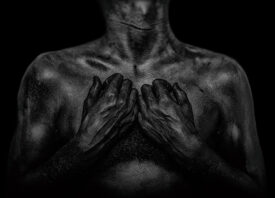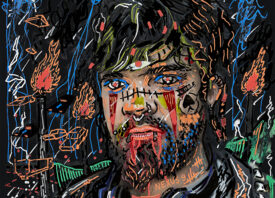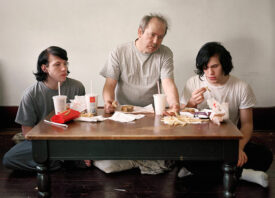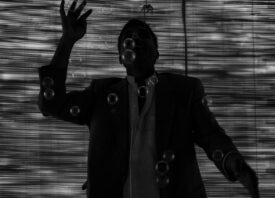Search this site
These 11 Photographers Are Challenging the Mental Health Stigma
One in five US adults experiences mental illness each year. I happen to be one of them. At least 8.4 million Americans provide care to an adult with an emotional or mental illness, and depression is the leading cause of disability worldwide. May is Mental Health Month, so this year, we took the opportunity to revisit some of the stories we’ve run on this complex subject.
These artists have explored mental health in different ways through a variety of media, from documentary photography to mixed-media collage. Some have documented their personal experiences, while others have collaborated with loved ones as they navigated mental health issues. Still more collaborated with mental health organizations and refuge centers to help bring unforgettable stories to light. While their experiences are unique, each one of them serves as a reminder of the importance of sharing our stories and listening to others.

Andrew Mangum Explores the Complex Truths of Addiction & Recovery
In 2017, Andrew Mangum was first introduced to some of the residents of Earl’s Place in Baltimore, a transitional housing program for people in recovery from addiction. He would go on to collaborate with many of them on a series of intimate portraits. “I made these portraits from a deeply personal space of truth, seen through the viewpoint of a photographer whose mother suffered from substance abuse,” he told Feature Shoot. “The viewer is going to bring their own experiences to the photographs and I just hope that after looking into the eyes of these men, you walk away with some kind of understanding or compassion.”

Susan J. Barron on Picturing PTSD, the Invisible Enemy
Through a series of portraits, the photographer Susan J. Barron gives voice to veterans coping with PTSD. “The invisible wounds of war can be just as devastating as the visible wounds, but it is difficult to get empathy or help for an injury you can’t see,” she says. “The telling of these stories has fostered a greater understanding of PTSD even between the veterans and their own families […] Veterans want their stories told. As Sgt Mike Burke said, ‘If we don’t talk about PTSD, we can’t save lives.'”

Doma Dovgialo Invites People to Create Self-Portraits That Challenge the Mental Health Taboo
The London photographer Doma Dovgialo collaborated with people she met at a mental health charity to create one-of-kind self-portraits. After photographing each participant, she invited them to draw over their portraits using an acetate sheet, bringing their thoughts and feelings into view. The project culminated in a book and exhibition. “Seeing them speak about their work and why they chose to draw what they did to the viewers was a defining moment for me,” she told us. “They truly played a huge part in how they were represented.”

Daniel Regan’s Behind-the-Scenes Look at a Suicide Respite Center
One year after he started volunteering at Maytree, suicide respite center in Finsbury Park, London, the photographer Daniel Regan and Natalie Howarth, the director at Maytree, embarked on a project together. That project, titled I Want to Live, includes photographs from the house itself as well as portraits and interviews with volunteers.
“For confidentiality and ethical reasons, I never photographed in the house when there were guests, but after they had left,” Regan told us. As a volunteer, one of his duties was to clean the rooms and make them up for the next guest. “I always take pride in making the room as nice as possible because I want people to feel that it is their safe place during their stay,” he says.
“Something that I’ll take from Maytree into the rest of my life is to never feel ashamed to talk about my difficulties. At Maytree we’re not there to fix someone; we’re there to allow people to speak openly about their crises. I think the motivation for me is that it is such an incredible privilege to be able to help people in suicidal crisis, particularly because I have been there myself.”

Rikard Osterlund’s Loving Portrait of His Wife and Her Illness
Rikard Osterlund has photographed his wife, Zara, for thirteen years. Zara is an artist, poet, and science fiction fan. She also happens to have fibromyalgia, hypermobility syndrome, OCD, and depression Osterlund’s photo book Look, I’m wearing all the colours is a candid record of their shared history, their sorrows and their joys. “Zara is not her illness,” the photographer says. “We have both learned to live with it being there, but it is not what defines her.”

Minimalist Snapshots of the World by Jacqui Kenny, ‘The Agoraphobic Traveller’
Jacqui Kenny is one of tens of millions of people worldwide living with agoraphobia, an anxiety disorder characterized by fear of public spaces, public transportation, open spaces, and/or large crowd. Still, she longs to travel the world. With the help of Google Street View, she has been able to visit faraway places that seem out of reach, and from the comfort of her home, she has photographed destinations thousands and thousands of miles from where she sits.

Mafalda Rakos’s Fearless Look at Eating Disorders
The photographer Mafalda Rakos collaborated with several friends as well as women she met at a self-help group for those in the midst of or in recovery from eating disorders. The mainstream media doesn’t always represent eating disorders accurately, and the women she met trusted her to tell their stories honestly. “Everyone who participated has authorized me to show [the photos],” she told me. “That was extremely important to me”

When the Netherlands-based photographer Laura Hospes was hospitalized following a suicide attempt, she took her camera with her into the unit where she received treatment. “I forced myself to go on making self-portraits,” she said at the time. “I just felt the need to ‘survive’ the horrible time. While photographing, I discovered it felt [like] such a [relief]. I was able to cry, to be angry, to be terrified and everything […] I was unable to show in real life.”

Liz Obert’s Photos Compare the Dual Lives of People Living with Mental Illness
“In Dualities, I seek to present the internal and external lives of people that have bipolar or major depressive disorder,” the photographer Liz Obert says. “Each component of this body of work consists of two portraits. One shows the subject presented, as they want to be seen to the outside world; in contrast, the other portrait is set in the space where they retreat into solitary moods.” Both photos are a collaboration between artist and subject, and the photographer herself, who lives with bipolar 2, also appears in the series.

Lisa Lindvay Captures the Devastating Effects of Mental Illness in Her Family
The Chicago-based photographer Lisa Lindvay created an intimate portrait of her family as they navigated her mother’s mental illness. “The day-to-day private struggles that my family has endured are not things that are easily put on public display,” she wrote. “However my family allowed me to turn my camera on them and openly and honestly share their story. I admire and appreciate their strength and courage during this turbulent time in their lives.”

Maureen Drennan Copes with Her Husband’s Depression Through Self-Portraits
Years ago, when her husband Paul fell into a depression, Maureen Drennan connected with him by taking pictures. The resulting body of work, titled The Sea That Surrounds Us, combines portraits of Paul at home and sweeping landscapes taken at Block Island, where the artist spent a part of her childhood. “The intimacy of making the photographs together during a challenging time was restorative,” she told me. “Where words failed us, the pictures filled in the blanks.”



